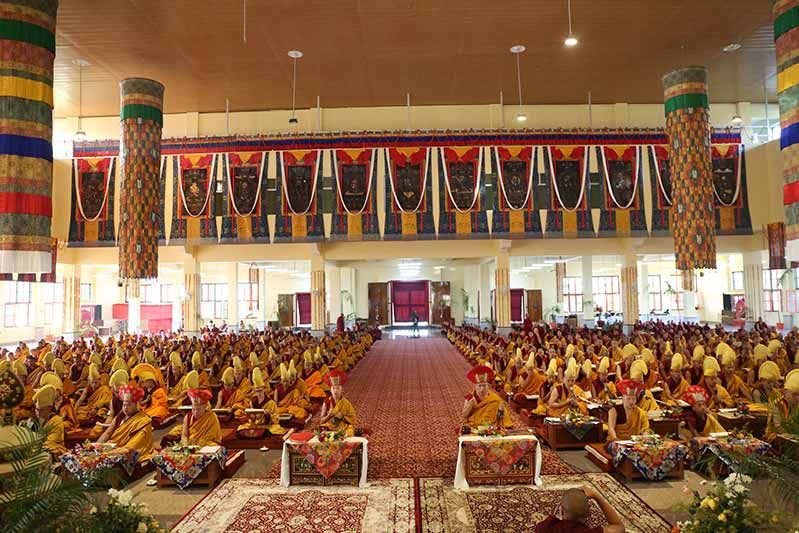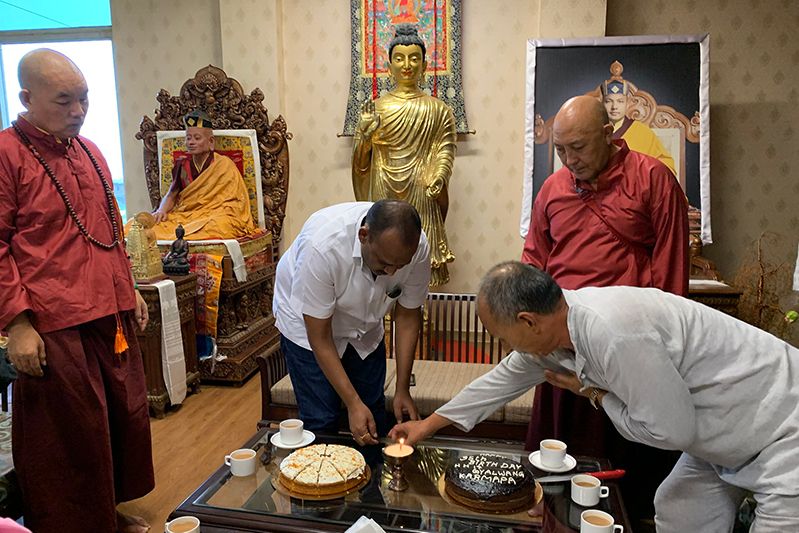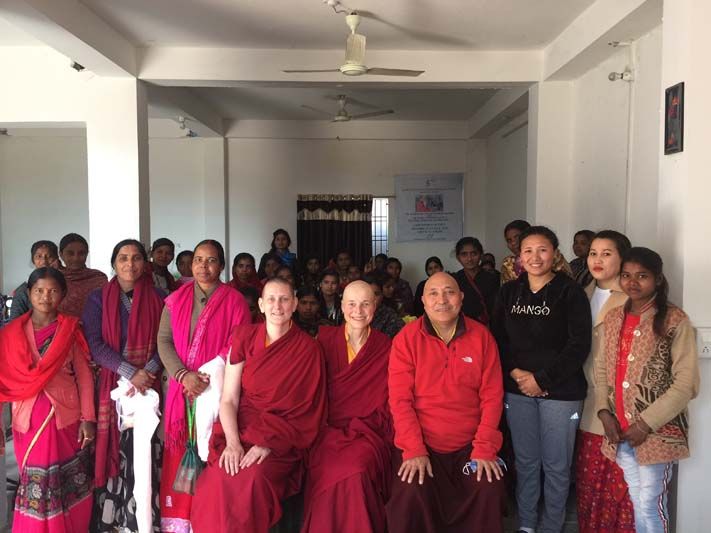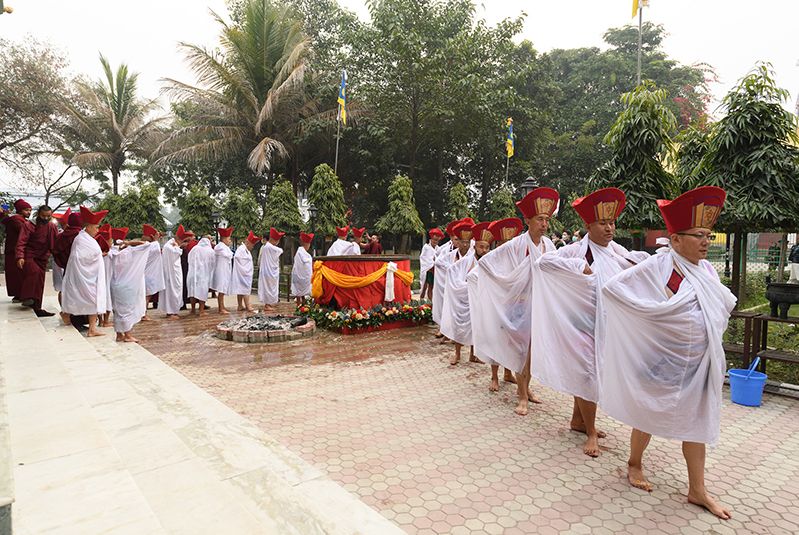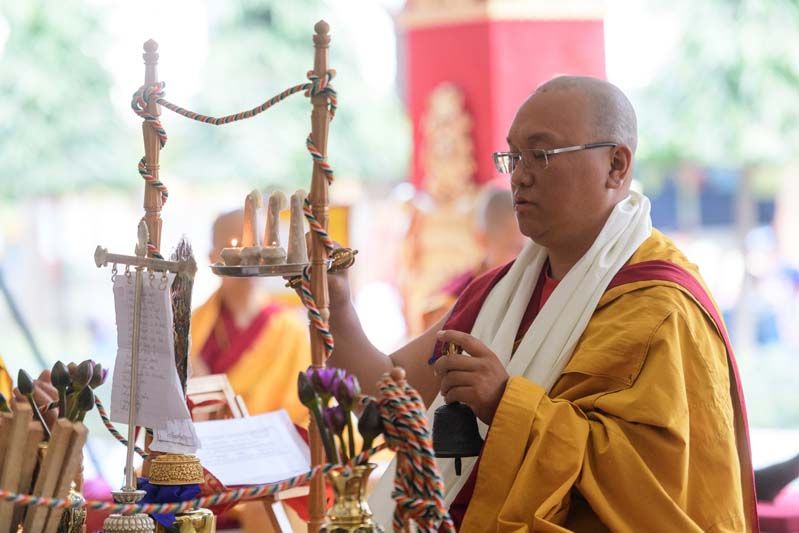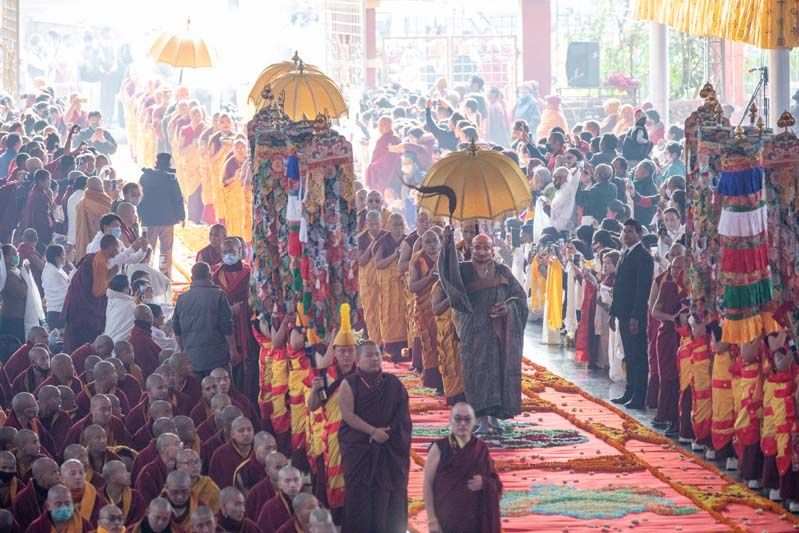Yongey Mingyur Rinpoche on the Four Foundations of Mindfulness Session 8: The Promise of Liberation
- January 30, 2020
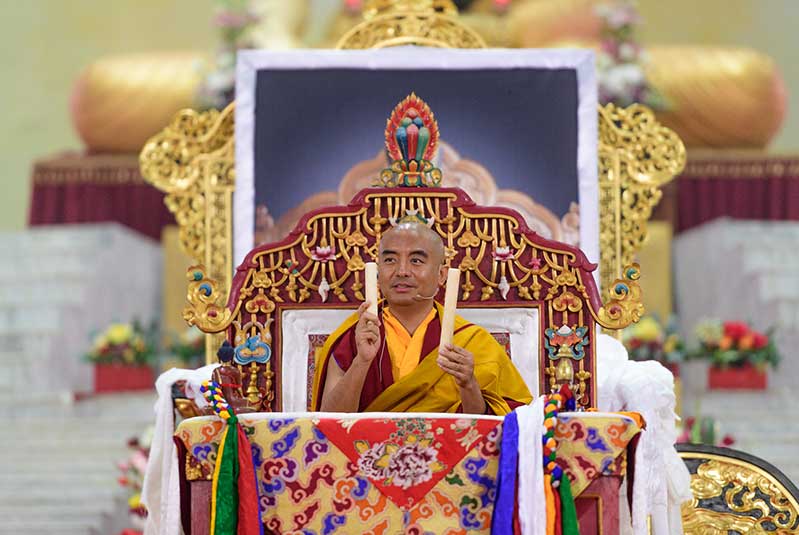
The Pavilion, Bodh Gaya, India
January 30, 2020
Question and answer session
The first question concerned how to maintain the stability of awareness in meditation.
Mingyur Rinpoche advised that the primary way to stabilise meditation is to meditate over and over again. It’s impossible at first to maintain awareness for a long time. The rule is “short periods, many times”. At the beginning, if we try to focus on one object for too long, we will experience dullness, torpor or agitation. As soon as we become distracted, we should stop and begin again. Gradually our meditation will transform from the river gushing down the mountain to the river flowing through the plains. Using the sound of his bell, Rinpoche demonstrated ‘short periods, many times’ and explained how our ability to meditate for longer periods will extend naturally but should not be forced.
The second question was about the three possible experiences in meditation that Mingyur Rinpoche had previously detailed. One of the young rinpoches described how sometimes it felt as if he were falling into an abyss, and then suddenly the awareness became clear.
Mingyur Rinpoche explained that this was an experience of emptiness. When this is very strong, you might see things, hear things, and smell things and so forth. This is the experience of the movement of the prana, he explained. There were four types of experience which could occur: seeing flashes of light like fireflies, deities and experiences through all five senses; feeling high or low; a feeling of electricity or warmth moving up and down your body—you can start shaking or crying; you feel the power of the guru. In general, he commented, this is good, because the channels, winds and drops within our body will transform from impure into pure, and eventually transform into wisdom, but it is essential not to become attached to these experiences. In particular, the appearances to the five senses are not true. If you feel strong movement and start shaking it is better to stop meditating for some time, do lots of exercise and drink lots of water, he recommended.
The third questioner asked how it was possible to direct attention towards a thought if that thought had disappeared and couldn’t be found.
Mingyur Rinpoche reminded everyone of the two experiences which can happen when meditating on thoughts: either you can look at them or you can’t. If it’s the latter, when you look at the thought you lose the thought, just rest right there in that lack of thoughts. It doesn’t imply lack of attention or awareness because you are aware that there is no thought. “There is no focus that you are directing your attention to, but you are resting without a focus.”
The next question concerned what to do when unpleasant or uncomfortable feelings arise in shamatha meditation. How can they be a focus for meditation?
Their primary cause, Mingyur Rinpoche commented, is attachment and aversion. If you feel that you must pacify them or make them go away, you have aversion, and that can make the uncomfortable feeling stronger. Sometimes there are feelings of attachment. As a beginner, if strong feelings arise, you may have to shift your focus.
A monk then asked three questions: about watching the breath in shamatha meditation; non-distraction in analytic meditation; and whether adopting the seven-point vajra position used in meditation constitutes ‘altering body and mind’.
Taking each question in turn, Rinpoche responded. In shamatha meditation, when you focus on the breath, the breath is impermanent and constantly changing. Your awareness should rest on that changing itself. The Treasury of Abhidharma talks about breathing in and out and not about staying whereas the Mahamudra describes four parts: breathing in; staying in; breathing out; resting out. This is the nature of the breath, going in and out all the time.
When practising the mindfulness of mind, thoughts constantly change because they are impermanent. Non- distraction here means one-pointed. It’s impossible to grasp one thought so our focus is on the constant change. When the object goes away, we look at that. If the object changes we focus on the change.
As to ‘altering body and mind’, Rinpoche explained that the body’s natural alignment is straight not hunched over, but when we first begin to meditate the body is out of alignment and the seven-point posture brings it into its correct line.
Focussed meditation brings on a headache, was the next concern. That’s the movement of the winds, Rinpoche explained, and suggested resting for a while and relaxing.
The final two questions were: Where do atoms go? How do we meditate on the breath and the impermanence of the breath simultaneously?
In the Foundation vehicle, particularly in the Great Exposition and the Sutra schools traditions, the ultimate truth is that part-less atoms and indivisible moments of cognition exist. The atoms are not lost; though the atoms change, the continuum does not. With reference to the flower that is burnt, some atoms go up as smoke, some become ashes, but they are not lost.
Replying to the second part, Rinpoche explained that as we breathe the breath is constantly changing, and if we know that it is changing, that is the basis of impermanence, which is the insight meditation of the Foundation vehicle. If, at the same time, we are aware of the breath, that is shamatha. So this is the union of shamatha and insight meditation.
The foundation of the mindfulness of dharmas
Rinpoche began the second part of the session by reviewing his exploration of selflessness from the previous session, which maintained that there is no permanent, singular, or autonomous self, which is the insight of the Foundation vehicle.
In the Mahayana tradition of vipashyana, when we examine objects, we discover that they are multiple, dependent, and impermanent, which correlates with the Foundation vehicle’s findings. However, the Mahayana then goes on to establish that multiplicity, dependency and impermanence is also not ultimately true. We understand that ‘Mingyur Tulku’ does not exist; it’s a mental projection onto the parts. The hand is made up of many parts, none of which is the hand. If we then dissect the parts, we arrive at the atoms and then at the indivisible atoms. The Great Exposition and Sutra schools maintain that these indivisible atoms truly exist. Beginning with the Mind Only school, the Mahayana traditions say that these indivisible particles cannot be found because it is impossible for a single atom to exist on its own. Vasubhandu, for example, states that when six are joined together, the part-less atoms would become six. Using six apples to symbolize six atoms, Rinpoche constructed a pyramid. Coarse objects are constructed of atoms. But if they are not assembled, coarse objects are not possible. And if mind were truly existent, it would have to have three parts: past, present and future. How then could it change? Modern Science began by maintaining that an atom could have no parts, but then they discovered sub-atomic particles, and further that they were constantly changing. This is a different way of looking, but the same meaning, Rinpoche stated. For the last ten or twenty years, scientists have learned that within a single atom 99% is empty. Within that 1%, 99% is also empty, and so on.
Mingyur Rinpoche continued with the theme of emptiness. “If age is emptiness, how then do we get older?” he asked. Because, he explained, alongside emptiness, there is appearance. Emptiness does not mean nothingness. Because of emptiness, everything is possible and all phenomena can occur. Without emptiness, nothing could happen. It is important to understand that emptiness and interdependence exist in union. When we talk about the logic of the great interdependence, it means that because nothing is truly existent, all phenomena can occur. We give names to mere appearances. At the same time that they appear, their essence is empty. Getting older is like an illusion.
As the Heart Sutra states: “Form is empty. Emptiness is form. Emptiness is not other than form. Form is not other than emptiness.” The meaning is that form, feeling, formation and consciousness are all empty. They do not truly exist. But this is not the view of nihilism because ‘emptiness is form’ ie. because of emptiness, forms are possible. When we look for ‘me’ we can’t find it. All phenomena are mere appearances. Rinpoche presented a conundrum. When you have a dream about receiving a new i-phone, then being mugged for it, you feel very distressed. But was it real or not?
The phone in the dream is not real in comparison to our waking, day-time life. But in the dream it was true, even though it didn’t have one atomic particle. All phenomena in samsara and nirvana are like that dream phone, “Appearing in union with emptiness. As they are appear, they are empty. As they empty, they appear.” We grasp at them as true because we do not recognise the union of appearance and emptiness. We continue in the cycle of samsara, birth, ageing, sickness and death, because we do not understand emptiness. We see the appearances of the nirmanakaya of Lord Buddha, but he himself was beyond the conceptions of birth, ageing, sickness and death. At the level of buddha, inconceivable wisdom, love and power become manifest. But we are enveloped in clinging to appearances. Even when things don’t exist we project them. Good and bad, subject and object do not exist. We are trapped within our own conceptual elaborations, like a silkworm in its cocoon. The basis of this is ignorance.
In order to free ourselves from samsara, we must realise the prajna of selflessness. There is nothing else that can liberate us. If we practise the true dharma of emptiness and compassion, we can liberate ourselves form samsara. No one else has the power to do that. If we directly know the nature of emptiness, we do not need to be afraid of anything.
“What is the best method to free ourselves from the fear in a nightmare before we wake up?” Rinpoche asked. Various solutions were posited but the most important answer according to Rinpoche is to recognise that the dream is a dream, as then, whatever dangers occur in the dream will have no effect on you. If you jump in fire, it cannot harm you. If a dream tiger eats you, there is no eating. If you jump off a 100-storey building you can fly. If you know it is a dream, you are liberated from all the sufferings of the dream and achieve control over it. But the dream doesn’t go away.
When you realise the ultimate meaning of emptiness, you know that all phenomena in samsara and nirvana are dreams as they actually are. You realise that the table is emptiness and see it as a dream or illusion. Your body is a dream or illusion; you do not actually experience birth, ageing sickness and death in your own perceptions.
When you achieve liberation or buddhahood, Rinpoche continued, it’s not referring to another place. ‘Samsara and nirvana are the same flavour’. When we experience samsara and realise emptiness, that itself is nirvana. However, it’s not as simple as recognising a dream as a dream. We can’t liberate ourselves from samsara immediately because of our strong imprints from the beginning of samsara and such strong attachment to dualistic appearances. In order to develop an understanding of emptiness, we have to meditate on it and practise over and over again until we experience emptiness on the path of joining. Then, on the path of seeing, we actually realise emptiness. Even then, we still have to progress through the bhumis to the tenth level. Only when we achieve buddhahood do we have control. We are liberated from birth, ageing, sickness and death and dualistic appearances. The greed, hatred and delusions of the obscurations, the cognitive and afflictive descriptions, are all purified. Like the lotus opening, we develop all the qualities of buddhahood—love, wisdom and power.
The morning teaching concluded on a high note when Rinpoche promised that even beginning to contemplate emptiness or to think that emptiness might be true has the power to purify the obscurations of many aeons.
བསོད་ནམས་དབང་རྒྱལ་ནས།
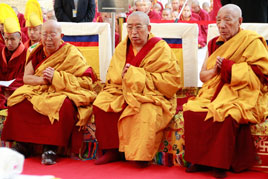
37th Kagyu Monlam Schedule
Tibetan / English / Chinese • French • German • Indonesian • Korean • Polish • Russian • Spanish • Vietnamese
Dharma Teachings
 Meditation Instructions
Meditation Instructions
Recorded during the 37th Kagyu Monlam, Bodhgaya, India. January 28-30, 2020.

